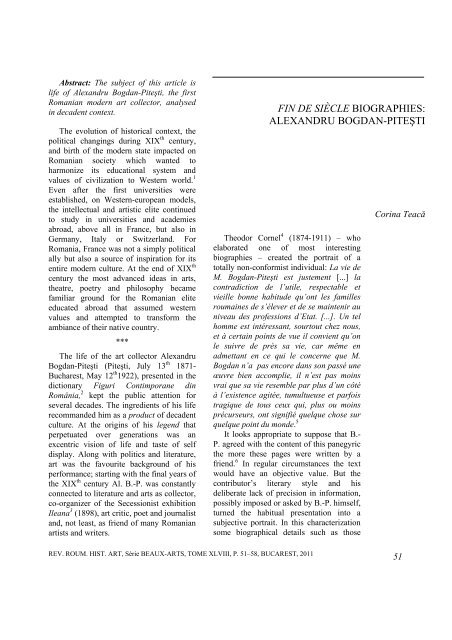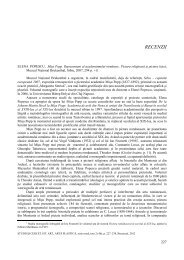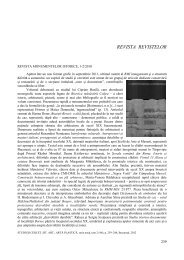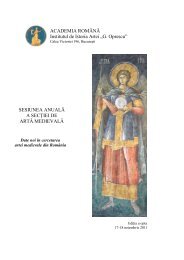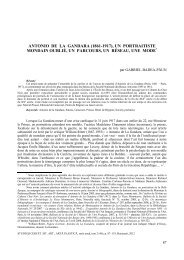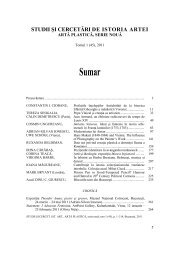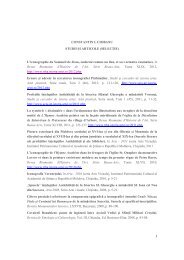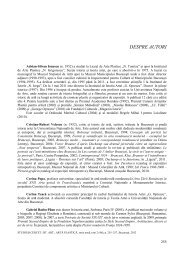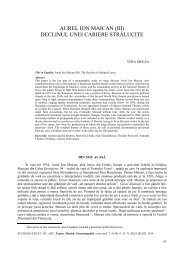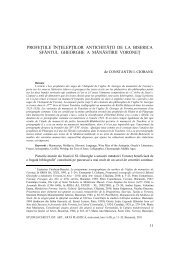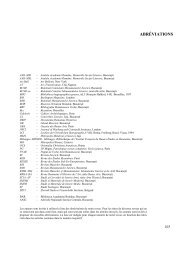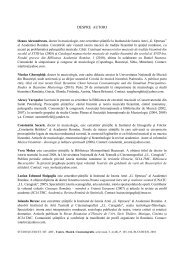RRHA 2011-Art 04-C. Teaca.pdf - Institutul de Istoria Artei
RRHA 2011-Art 04-C. Teaca.pdf - Institutul de Istoria Artei
RRHA 2011-Art 04-C. Teaca.pdf - Institutul de Istoria Artei
Create successful ePaper yourself
Turn your PDF publications into a flip-book with our unique Google optimized e-Paper software.
Abstract: The subject of this article is<br />
life of Alexandru Bogdan-Piteşti, the first<br />
Romanian mo<strong>de</strong>rn art collector, analysed<br />
in <strong>de</strong>ca<strong>de</strong>nt context.<br />
The evolution of historical context, the<br />
political changings during XIX th century,<br />
and birth of the mo<strong>de</strong>rn state impacted on<br />
Romanian society which wanted to<br />
harmonize its educational system and<br />
values of civilization to Western world. 1<br />
Even after the first universities were<br />
established, on Western-european mo<strong>de</strong>ls,<br />
the intellectual and artistic elite continued<br />
to study in universities and aca<strong>de</strong>mies<br />
abroad, above all in France, but also in<br />
Germany, Italy or Switzerland. For<br />
Romania, France was not a simply political<br />
ally but also a source of inspiration for its<br />
entire mo<strong>de</strong>rn culture. At the end of XIX th<br />
century the most advanced i<strong>de</strong>as in arts,<br />
theatre, poetry and philosophy became<br />
familiar ground for the Romanian elite<br />
educated abroad that assumed western<br />
values and attempted to transform the<br />
ambiance of their native country.<br />
***<br />
The life of the art collector Alexandru<br />
Bogdan-Piteşti (Piteşti, July 13 th 1871-<br />
Bucharest, May 12 th 1922), presented in the<br />
dictionary Figuri Contimporane din<br />
România, 2 kept the public attention for<br />
several <strong>de</strong>ca<strong>de</strong>s. The ingredients of his life<br />
recomman<strong>de</strong>d him as a product of <strong>de</strong>ca<strong>de</strong>nt<br />
culture. At the origins of his legend that<br />
perpetuated over generations was an<br />
excentric vision of life and taste of self<br />
display. Along with politics and literature,<br />
art was the favourite background of his<br />
performance; starting with the final years of<br />
the XIX th century Al. B.-P. was constantly<br />
connected to literature and arts as collector,<br />
co-organizer of the Secessionist exhibition<br />
Ileana 3 (1898), art critic, poet and journalist<br />
and, not least, as friend of many Romanian<br />
artists and writers.<br />
FIN DE SIÈCLE BIOGRAPHIES:<br />
ALEXANDRU BOGDAN-PITEŞTI<br />
Theodor Cornel 4 (1874-1911) – who<br />
elaborated one of most interesting<br />
biographies – created the portrait of a<br />
totally non-conformist individual: La vie <strong>de</strong><br />
M. Bogdan-Piteşti est justement [...] la<br />
contradiction <strong>de</strong> l’utile, respectable et<br />
vieille bonne habitu<strong>de</strong> qu’ont les familles<br />
roumaines <strong>de</strong> s’élever et <strong>de</strong> se maintenir au<br />
niveau <strong>de</strong>s professions d’Etat. [...]. Un tel<br />
homme est intéressant, sourtout chez nous,<br />
et à certain points <strong>de</strong> vue il convient qu’on<br />
le suivre <strong>de</strong> près sa vie, car même en<br />
admettant en ce qui le concerne que M.<br />
Bogdan n’a pas encore dans son passé une<br />
œuvre bien accomplie, il n’est pas moins<br />
vrai que sa vie resemble par plus d’un côté<br />
à l’existence agitée, tumultueuse et parfois<br />
tragique <strong>de</strong> tous ceux qui, plus ou moins<br />
précurseurs, ont signifié quelque chose sur<br />
quelque point du mon<strong>de</strong>. 5<br />
It looks appropriate to suppose that B.-<br />
P. agreed with the content of this panegyric<br />
the more these pages were written by a<br />
friend. 6 In regular circumstances the text<br />
would have an objective value. But the<br />
contributor’s literary style and his<br />
<strong>de</strong>liberate lack of precision in information,<br />
possibly imposed or asked by B.-P. himself,<br />
turned the habitual presentation into a<br />
subjective portrait. In this characterization<br />
some biographical <strong>de</strong>tails such as those<br />
REV. ROUM. HIST. ART, Série BEAUX-ARTS, TOME XLVIII, P. 51–58, BUCAREST, <strong>2011</strong><br />
Corina Teacă<br />
51
52<br />
related to educational background remain<br />
uncertain, thus giving way to speculations.<br />
For obscure reasons a heavy silence<br />
surrounds his childhood and adolescence.<br />
Apparently he spent a few years in<br />
Switzerland where he completed his<br />
education. Then he <strong>de</strong>ci<strong>de</strong>d to move out to<br />
Paris where he lived until 1894 when a<br />
political scandal and his links to anarchist<br />
circles drew his expulsion from France.<br />
Self-taught or formal educated? Nothing<br />
testifies his enrolment in a French or<br />
Swiss university although there are a few<br />
hypotheses in this sense. 7 La vie <strong>de</strong><br />
M. Bogdan-Piteşti est justement [...] la<br />
contradiction <strong>de</strong> l’utile... wrote Th. Cornel<br />
at the begining of XX th century suggesting<br />
a constant oposition to every form of<br />
authority. The French ambience could be<br />
consi<strong>de</strong>red as a true birth place where his<br />
personality, rebel views and sense of drama<br />
encountered a<strong>de</strong>quate conditions to evolve.<br />
In France he lived a Bohemian life in<br />
company of famous intellectuals and<br />
radical political activists. These two years<br />
spent in Paris allowed him to get his own<br />
pessimistic vision of the world. Fără<br />
îndoială, Bogdan-Piteşti a dus la Paris o<br />
viaţă plină <strong>de</strong> plăceri, încercând până la<br />
vârsta <strong>de</strong> 23 <strong>de</strong> ani o largă gamă <strong>de</strong><br />
experienţe aventuroase, <strong>de</strong> la cele erotice<br />
la cele financiar dubioase şi până la fiorii<br />
turbulenţi ai anarhismului. Propensiunea<br />
lui timpurie spre senzaţiile rafinate şi<br />
frizând morbidul, promovate <strong>de</strong> poezia şi<br />
arta mo<strong>de</strong>rnă, spre simbolism şi wagnerism<br />
[(...)], merg împreună cu experienţele <strong>de</strong><br />
viaţă libertine. [There is no doubt that in<br />
Paris B.-P. had a life of pleasures,<br />
exploring until the age of 23 a large range<br />
of adventurous experiences, from erotic<br />
ones to those dubiously financial and to<br />
boisterous shivers of anarchism. His early<br />
fondness of refined sensations bor<strong>de</strong>ring on<br />
morbidity, promoted by the mo<strong>de</strong>rn poetry<br />
and art, his ten<strong>de</strong>ncy towards symbolism<br />
and wagnerism (...) conjoin with libertine<br />
experiences.] 8 The aspect has its relevance<br />
in un<strong>de</strong>rstanding the result of a lifetime<br />
self-building process that began in Geneve,<br />
Switzerland, where the young B.-P.<br />
converted to Catholicism. Whatever the<br />
motivation of his conversion, that event<br />
was the first (and successful) attempt to<br />
<strong>de</strong>tach from tradition, <strong>de</strong>ny it; in the further<br />
years a complete new man was shaped.<br />
Geneve also was an important centre for the<br />
<strong>de</strong>velopment of anarchist movement, and<br />
it’s nothing unusual in searching the<br />
company of people with similar views in<br />
Paris. The links to this medium eventually<br />
could explain his vision on sexuality and a<br />
part of the options he took. 9 The life in<br />
Paris allowed him to reflect and construct<br />
his own human i<strong>de</strong>al. In Cornel’s article,<br />
the names of many great French writers like<br />
Paul Verlaine, Maurice Barrés, Laurent<br />
Tailha<strong>de</strong>, J.-K. Huysmans, Joséphin Péladan,<br />
etc. were given as social and (perhaps)<br />
professional connections or friends.<br />
Excepting Sâr Péladan, whose presence at<br />
Bucharest in 1898 as guest of B.-P.<br />
confirms the existence of a certain relation<br />
between them 10 , the rest of those French<br />
connections still remain to be documented.<br />
At his arrival in Romania he tried to recreate<br />
the atmosphere of emulation he<br />
missed. His salon, the exhibition Ileana, his<br />
activity as art critic, all these indicate that<br />
he had in mind a precise social pattern to<br />
follow. In his views, the features of i<strong>de</strong>al<br />
being combined the skills and cultural<br />
interests – art and art criticism, journalism,<br />
poetry – of educated men he met in France:<br />
Fénéon, Péladan and Huysmans. In straight<br />
connection to this social image B.-P.<br />
shaped a persona: the real man remained an<br />
enigma for almost all people around him.<br />
He used to be a showman always bluffing<br />
and hiding his feelings and every part of his<br />
public image was a removable mask. (Ill.<br />
1). A psychological motivation of this<br />
versatility – as F. Feifer 11 suggested –<br />
offers a partial answer. Maybe the<br />
personality of Felix Fénéon (1861-1944),<br />
whose name was mentioned by Cornel<br />
among his Paris acquaintances, inspired<br />
him in constructing his i<strong>de</strong>ntity.
Terms as double existence, enigma, that<br />
could <strong>de</strong>fine B.-P.’s way of life of are used<br />
by J.U. Halperin 12 to <strong>de</strong>scribe F. Fénéon.<br />
Out of the many conflicting aspects of his<br />
life and character, he built his own<br />
persona. His style, how he spoke, dressed,<br />
joked, wrote, ma<strong>de</strong> love, was the fruit of his<br />
individual imagination. Everything from his<br />
anarchism 13 to his syntax was shaped<br />
<strong>de</strong>liberately. His style of writing was as<br />
contrived and composed as his top-hated<br />
appearance; often difficult to <strong>de</strong>cipher,<br />
sometimes crystalline and always terse,<br />
“cuneiform”. Because of a consummate<br />
sense of style, he was able to conduct a<br />
double or a triple existence with “absolute<br />
integrity”. The psychological contradictions<br />
remarked equally by friends and enemies<br />
could be consi<strong>de</strong>red as distinct facets of a<br />
complex personality. By playing this mask<br />
Fig. 1 – Don, Alexandru Bogdan-Piteşti, 1916, BAR.<br />
game he tries, as Fénéon did, 14 a number of<br />
human possibilities.<br />
Another posible source for this<br />
<strong>de</strong>velopment could be found in the <strong>de</strong>ca<strong>de</strong>nt<br />
literature. Symbolist and <strong>de</strong>ca<strong>de</strong>nt authors<br />
were well-known to the romanian public<br />
which had recognized in this fin <strong>de</strong> siècle<br />
literary corpus his own image and<br />
sensitivity. 15 In this regard, a testimony<br />
about this relation between fiction and life<br />
belongs to Ilarie Chendi who, writing about<br />
Maurice Maeterlinck, reveals the echoes of<br />
his work in certain Romanian circles. 16<br />
Zafiu’s study on Romanian symbolist poetry<br />
put in evi<strong>de</strong>nce the topics of the fin <strong>de</strong> siècle<br />
generation not only in literary terms but also<br />
seen as social and existential patterns <strong>de</strong>eply<br />
rooted in literature. 17<br />
***<br />
53
54<br />
Beyond the controversial around his<br />
non-ethical behaviour – subject never<br />
neglected by historians – his contribution to<br />
Romanian mo<strong>de</strong>rnism was essential. 18 His<br />
dwelling place generously opened to<br />
friends turned into a crucible where new<br />
trends in arts and poetry were melting. The<br />
careers of important Romanian painters as<br />
Ştefan Luchian (1868-1916), Camil Ressu 19<br />
(1880-1962) were stimulated not only by<br />
his financial support but also by the<br />
uninhibited intellectual atmosphere he<br />
cultivated at his place 20 where rough farces,<br />
mockery, black humour, irony, licentious<br />
speech, even insults, competed with serious<br />
<strong>de</strong>bates on arts and literature. 21 Early<br />
sources mention the studio he created in<br />
1898 in his own apartment situated in<br />
Bucharest Brezoianu Street, 22 moved away<br />
later in the house of Ştirbey Vodă Street. In<br />
that studion, paints, canvases, cartoons, and<br />
mo<strong>de</strong>ls were provi<strong>de</strong>d for free to young and<br />
poor artists. Addicted to beauty, 23 B.-P. was<br />
– starting with the final years of the XIX th<br />
century – the singular private patron of arts<br />
in the Romanian Kingdom.<br />
The unusual existence in individualistic,<br />
shocking sense, shadowed the rest of his<br />
actions in spite of plenty magnanimous<br />
gestures and involvement in Bucharest’s<br />
artistic life – positions that brought him<br />
popularity among some artists and<br />
intellectuals; his <strong>de</strong>fen<strong>de</strong>rs had to fight<br />
against the almost general disapproval<br />
prevailing in the contemporary judgements.<br />
Nobody could ignore his extravagant and<br />
cinical behave. The Romanian sculptor<br />
Oscar Han (1891-1976), a sharp observer,<br />
presented him as a strange individual,<br />
dangerously charming, daring to challenge<br />
the society and its moral rules. 24 In general,<br />
the <strong>de</strong>scriptions ma<strong>de</strong> by contemporary<br />
people concord, and in many occasions<br />
beyond the blame and disdain it looms out<br />
a kind of (somewhat repressed) fascination.<br />
It was the case of Han himself whose<br />
memories regarding B.-P. reflect not<br />
entirely severe criticism but certain<br />
acceptance and discrete admiration. 25 At his<br />
turn, the art collector Krikor H.<br />
Zambaccian (1889-1962) 26 , seemed to be<br />
the victim of a similar seduction. 27 For<br />
strong reasons his circle saw in him not a<br />
comedian or a crook, but human energy led<br />
by rules <strong>de</strong>rived from fin <strong>de</strong> siècle<br />
literature, where life itself is worshiped as a<br />
real masterpiece.<br />
The amplitu<strong>de</strong> of the controversy<br />
regarding his outrageous attitu<strong>de</strong> could be<br />
seen in the fact that at a short while after<br />
B.-P.’s <strong>de</strong>ath, the literary critic Eugen<br />
Lovinescu (1881-1943) disputed publically<br />
the subject with Benjamin Fondane (1898-<br />
1944) in one of the most influential literary<br />
magazine Sburătorul literar. 28 It’s not a<br />
coinci<strong>de</strong>nce that Fondane, a friend,<br />
speaking about him, amplified the leit-motif<br />
of life as a supreme embodiment of genius.<br />
Bogdan-Piteşti şi-a pus geniul în viaţă. A<br />
fost unul dintre puţinii convivi vrednici <strong>de</strong><br />
banchetul lui Platon; prezenţa lui între<br />
Aristofan şi Agathon ar fi sporit comoara<br />
puţină a cuvintelor inefabile. În conversaţia<br />
<strong>de</strong>spre dragoste ar fi spus, poate, cu o<br />
neclătinată linişte, cele mai uimitoare<br />
paradoxuri. Nu, <strong>de</strong>sigur, nu era Socrate: nu<br />
gusta, nu putea gusta elevaţia morală: era<br />
un simplu Alcibia<strong>de</strong>, zvelt, orgolios şi cinic;<br />
dar dacă nu era un Socrate, putea fi<br />
slăbiciunea unui Socrate. 29 In Fondane’s<br />
words, the life of A. B.-P. represented a<br />
lively amoralism in the line of the writings<br />
of W. H. Pater (1839-1894): Not the fruit of<br />
experience, but the experience itself, is the<br />
end. [...] To burn always with this hard,<br />
gemlike flame, to maintain this ecstasy, is<br />
success in life. In a sense it might even be<br />
said that our failure is to form habits: for,<br />
after all, habit is relative to a stereotyped<br />
world, and meantime it is only the<br />
roughness of the eye that makes any two<br />
persons, things, situations, seem alike. 30<br />
Forcing the limits of common sense,<br />
ignoring <strong>de</strong>liberately the moral principles<br />
or even breaking the law, B.-P. did nothing<br />
else than remain faithful to his instincts: To<br />
be good is to be in harmony with oneself<br />
[...]. Discord is to be forced to be in<br />
harmony with others. One’s own life – that<br />
is the important thing. 31 These sentences
from The Picture of Dorian Gray by Oscar<br />
Wil<strong>de</strong> (1891) explain solely a constant<br />
rebel attitu<strong>de</strong>. A similar point of view was<br />
<strong>de</strong>veloped by the German philosopher<br />
Friedrich Nietzsche just few years before<br />
(1888): Every mistake (in every sense of the<br />
word) is the result of a <strong>de</strong>generation of<br />
instinct, a disintegration of the will: one<br />
could almost equate what is bad with<br />
whatever is a mistake. All that is good is<br />
instinctive — and hence easy, necessary,<br />
uninhibited. Effort is a failing: the god is<br />
typically different from the hero. 32<br />
***<br />
To the amoral perspective of life must<br />
integrate the chapter of his homosexual/<br />
bisexual option (true or imaginary). Mateiu<br />
Caragiale (1885-1936) – a versatile and<br />
caustic commentor of B.-P., ma<strong>de</strong> him in<br />
his diary a contradictory portrait: he used to<br />
be a pretty cheap clown [...] pretending to<br />
be the same time anarchist and Catholic,<br />
boaster pe<strong>de</strong>rast <strong>de</strong>spite he was sexually<br />
impotent and handicapped [...]. 33<br />
During the years his sexuality seemed to<br />
evolve into bisexuality and later in<br />
homosexuality. The women had an<br />
ephemeral presence in his life. They<br />
represented transitory options and their<br />
i<strong>de</strong>ntities – except for his mother and sister,<br />
and towards the end of life, his wife –<br />
remain unknown. For some years the<br />
official option was his wife, Mica. 34 One<br />
can say that it was only a conventional<br />
relationship able to hi<strong>de</strong> his real sexual<br />
orientation. But what kind of person was<br />
Mica? They knew Bogdan-Piteşti met her<br />
in sordid circumstances while she was a<br />
singer. She sometimes used to wear man<br />
suites, and short cut hair. This is the way<br />
Camil Ressu portrayed her. 35 Her youth<br />
presence iradiated a masculine air and her<br />
figure seemed to be a counterpart of the<br />
male i<strong>de</strong>al. A possible (and certainly partly)<br />
suggestion for his choice could be given by<br />
the <strong>de</strong>ca<strong>de</strong>nt (Villiers <strong>de</strong>l’Isle Adam, Joris-<br />
Karl Huysmans, Rachil<strong>de</strong>, Joséphin<br />
Péladan and so on) as well as feminist<br />
literature, both of them touching the<br />
dialogue between masculine and feminine,<br />
the force balance of these principles. 36<br />
Rudolf Lothar <strong>de</strong>tected at that age a<br />
feminine will of power who took over some<br />
of the male atributs, and the reverse<br />
phenomenon, the weakness of the man . 37<br />
In the same period an entire production of<br />
books on the subject of gen<strong>de</strong>r’s nature and<br />
sexual <strong>de</strong>viations was published. It was the<br />
case of J. Chevalier who in 1893 published<br />
an exhaustive work on the sexual inversion<br />
seen as a psycho-physical disease. 38 He<br />
<strong>de</strong>scribes it as: À l’état normal, [...] la<br />
sexualité toute entière, consonnante et<br />
stable, est déterminée par l’organe, elle<br />
vient d’en bas, il y a action du physique sur<br />
le moral; ici, la portion variable <strong>de</strong> la<br />
sexualité est déterminée par le centre<br />
cérébral, elle vient d’un haut. Purement<br />
psychique au début, la déviation s’organise<br />
consécutivement, non par une métamorphose<br />
<strong>de</strong> l’appareil génital, mais par une<br />
modification quelquefois remarcable <strong>de</strong>s<br />
formes extérieures. C’est là un effet du<br />
moral sur le physique. La personnalité <strong>de</strong><br />
l’individu subit une profon<strong>de</strong> atteinte par<br />
cette sorte d’hermaphrodisme immatériel;<br />
l’unité du moi est détruite: <strong>de</strong>ux sexes dans<br />
un. A vrai dire, un troisième sexe est né. 39<br />
In the personal album of B.-P. is saved a<br />
drawing representing a young male nu<strong>de</strong>,<br />
having below the picture’s frame a couple<br />
of lines from Bau<strong>de</strong>laire’s poem, La<br />
Beauté. (Ill. 2) His ambiguous presence, his<br />
feminine passive pose might be an allusion<br />
to the collector’s presumed homosexuality.<br />
It looks like a shift of roles in the terms of<br />
J. Chevalier. Oscar Han remembered a<br />
<strong>de</strong>sgusting scene he assisted in his studio<br />
when B.-P. introduced to him his boyfriend<br />
(Aurel Brătăşanu, the author of drawing)<br />
for an over-sized nu<strong>de</strong> portrait. Han uses<br />
the word <strong>de</strong>generate in his <strong>de</strong>scribing the<br />
young man, a term which indicates equally<br />
the character of this relationship, the<br />
<strong>de</strong>vitalized nature of this mo<strong>de</strong>l and at the<br />
same time – although maybe unwillingly –<br />
a cultural reference. One could consi<strong>de</strong>r<br />
these facts as matters of pure psychology.<br />
55
Notes<br />
56<br />
But they really were just that? Even his<br />
bi/homosexuality – as a complete<br />
experience of the sexuality could be<br />
aesthetically interpreted, as eagerness for<br />
i<strong>de</strong>al beauty: we find the confirmation in<br />
the article of Gabriel Dona resuming the<br />
question of i<strong>de</strong>al in the work of Joséphin<br />
Péladan: I<strong>de</strong>alul frumuseţei omenesci<br />
pentru dânsul [for Péladan] este acest tip,<br />
în care sexul nu apare, androgynul, fiinţa<br />
1<br />
Lucian Boia, Istorie şi mit în conştiinţa<br />
românească, Bucureşti, 1997.<br />
2<br />
(Coord.) Theodor Cornel, Figuri Contimporane<br />
din Romania, Bucureşti, 1909.<br />
3<br />
Bucharest, 1898.<br />
4<br />
Pseudonym of Toma Dumitriu.<br />
5<br />
Th. Cornel, op. cit., p. 340.<br />
6<br />
Florin Feifer, Între lumini şi penumbre: Al.<br />
Bogdan-Piteşti, in Revista <strong>de</strong> istorie şi teorie literară,<br />
XXXVII, no. 1-2, Ianuary-June, 1989, p. 251.<br />
7<br />
According to F. Feifer, he studied the<br />
Medicine in Montpellier and later in Paris the Letters<br />
and Law. Florian Feifer, art. cit; on the other si<strong>de</strong>,<br />
Sanda Miller in her article on Paciurea’s Chimeras<br />
mentions B.-P. as a former stu<strong>de</strong>nt at École <strong>de</strong>s<br />
Beaux-<strong>Art</strong>s in Paris: The former [B.-P.], who managed<br />
to get himself expelled from the École <strong>de</strong>s Beaux-<strong>Art</strong>s in<br />
Paris, where he befrien<strong>de</strong>d Sâr Joséphin Péladan… online:<br />
http://www.thefreelibrary.com/ Paciurea's Chimeras<br />
Fig. 2 – Alexandru Brătăşanu, Nu<strong>de</strong>, pencil drawing, BAR.<br />
în căutare <strong>de</strong> adolescenţi, care reuneşte<br />
graţia, ovalul şi sentimentul femeii cu forţa,<br />
musculatura şi inteligenţa bărbatului. 40<br />
More again Oscar Han’s records offers us a<br />
precious documentary source which<br />
confirms that supposition. In the same text<br />
he inclu<strong>de</strong>s an short anecdote which lets us<br />
know the collector’s opinion on human<br />
physical beauty, his full admiration for<br />
masculine anatomy. 41<br />
8 Theodor Enescu, Scrieri <strong>de</strong>spre artă, II,<br />
Bucureşti, 2003, p. 34.<br />
9 ...they [anarchists] saw the liberation of sexuality<br />
as taking place not within the totality of society but in<br />
small local units such as families, communes, or<br />
partnerships. Some anarchists practiced alternatives to<br />
conventional sexual institutions, such as Lillian<br />
Harman's (1869–1929) “autonomistic marriage” in<br />
1886; however, the total refusal of institutionalized<br />
relationships seems to have been the most common<br />
answer. Etc. Hiram Kümper, Anarchism and sexuality<br />
on-line: http://www.blackwellreference.com/public/<br />
10 I<strong>de</strong>m, p. 269. According to Th. Enescu B.-P.’s<br />
library contained the complete works of Péladan<br />
(mentioned in the inventory of 1923). J. Péladan signed<br />
and <strong>de</strong>dicated a copy of his Babylon (1895) to B.-P.:<br />
Votre idéal est ici exprimé mon cher Bogdan ...etc.<br />
11 Feifer, art cit., p. 251.<br />
12 Joan Ungersma Halperin, Félix Fénéon,<br />
Aesthete and Anarchist in Fin-<strong>de</strong>-siècle Paris, New<br />
Haven and London, 1988, p. 5, 6.
13<br />
Fénéon and Bogdan-Piteşti had in common<br />
anarchist views.<br />
14<br />
For some observations on J. U. Halperin’s<br />
book see Hilton Kramer <strong>Art</strong>, anarchism & Félix<br />
Fénéon in The New Criterion, May 1989. online:http://www.newcriterion.com/articles.cfm/<strong>Art</strong>anarchism---F-lix-F-n-on<br />
15<br />
Pesimismul mo<strong>de</strong>rn e un <strong>de</strong>generat nervoziceşte,<br />
e un enervat. Acesta e principalul semn fiziologic<br />
(patologic) al lui. În legătură cu această <strong>de</strong>generare<br />
şi slăbire nervoasă e slăbirea voinţei, o disproporţie<br />
mare între voinţă şi inteligenţă. Nu în zadar îl<br />
numesc criticii francezi pe pesimistul mo<strong>de</strong>rn un<br />
impuissant. Constantin Dobrogeanu-Gherea Cauza<br />
pesimismului în literatură şi artă, first published in<br />
Studii critice, II, Bucureşti, 1891.<br />
16<br />
Societatea noastră ca şi cea din alte capitale, e<br />
predispusă a îmbrăţişa pe Maeterlinck nu numai ca<br />
artist subtil, ci şi ca gânditor, şi nu atât pe<br />
Maeterlinck cel <strong>de</strong> astăzi, <strong>de</strong>venit mai clar şi mai<br />
viguros în toată opera sa, ci şi pe creatorul<br />
încercărilor filozofice Trésor <strong>de</strong>s humbles şi La<br />
sagesse et la Destinée. [...] în general, întreaga<br />
atmosferă mistică din lucrările aceste trebuie să<br />
placă mult unei societăţi obosite, senzitive şi<br />
incapabilă <strong>de</strong> emoţiuni mai puternice. Cel puţin aşa<br />
îmi închipui, că Maeterlinck nu este numai poetul, ci<br />
chiar filozoful pentru care o parte a societăţii noastre<br />
fatal trebuie să se entuziasmeze. Şi dacă nu-l<br />
înţelege, îl simte cel puţin, cum simţi orice scriere cu<br />
al cărei fond sufletesc eşti înrudit. Ilarie Chendi,<br />
Scrieri, Foiletoane, 1903-19<strong>04</strong>, Minerva, Bucureşti,<br />
1990, Spleen p. 159-160.<br />
17<br />
La începuturile simbolismului românesc punerea<br />
în scenă a vieţii literare e poate chiar mai spectaculoasă<br />
<strong>de</strong>cât operele scrise. Ca şi la Paris, <strong>de</strong>ca<strong>de</strong>nţa,<br />
simbolismul, poezia nouă sunt un mod <strong>de</strong> viaţă pe<br />
jumătate ostentativ, cabotin, pe jumătate autentic,<br />
chiar dramatic. Rodica Zafiu, Poezia simbolistă<br />
românească, Bucureşti, 1996, p. 22.<br />
18<br />
Theodor Enescu, Scrieri <strong>de</strong>spre artă, II: <strong>Art</strong>ă şi<br />
context cultural în România primelor <strong>de</strong>cenii ale<br />
secolului XX, Bucureşti, 2003 (edition coordinated by<br />
Ioana Vlasiu); the chapter Primul muzeu <strong>de</strong> artă<br />
românească mo<strong>de</strong>rnă: colecţia Alexandru Bogdan-<br />
Piteşti. See also Paul Cernat, Avangarda românească<br />
şi complexul periferiei, Bucureşti, 2007, the chapter<br />
Alexandru Bogdan-Piteşti: un animator controversat<br />
al primului mo<strong>de</strong>rnism autohton.<br />
19<br />
Victor Eftimiu, Portrete şi amintiri, Bucureşti,<br />
1965, p. 419-420: Camil Ressu ca şi alţi pictori tineri,<br />
necunoscuţi, a găsit mult sprijin şi încurajare la<br />
Bogdan-Piteşti. E a<strong>de</strong>vărat că mecenatul era cam<br />
meschin, că profita <strong>de</strong> nevoia artistului <strong>de</strong>butant şi<br />
sărac. Dar fără el ar fi fost mult mai rău, fiindcă alţii<br />
nu ofereau nici măcar atât; Bogdan-Piteşti. Cel puţin<br />
le crea un cadru artistic, îi stimula, îi recomanda, le<br />
ţinea la dispoziţie vopsele, pensule şi cartoane, îi<br />
poftea la masă, le dă<strong>de</strong>a şi sfaturi în casa lui<br />
călduroasă şi amicală. Multe prietenii s-au legat<br />
acolo, mulţi oameni au prins curaj: pictorii să lucreze,<br />
colecţionarii să adune.<br />
20<br />
Alexandru Macedonski, Alexandru Bogdan-<br />
Piteşti, in Literatorul, 5 April 1899, p. 4-5.<br />
21<br />
Twenty two years after B.-P.’s <strong>de</strong>ath, a friend and<br />
frequent visitor of his house, the woman-painter Cecilia<br />
Cuţescu-Storck (1879-1969) explains in her biography<br />
in what exactely consist of the importance of this figure.<br />
Bogdan-Piteşti a jucat rolul unui Mecena animator,<br />
creând un cenaclu unic în felul lui la noi, întrunind<br />
artiştii la lungi discuţii şi teorii interesante <strong>de</strong> artă,<br />
împrejurul unei mese copioase. Cecilia Cuţescu-Storck,<br />
Fresca unei vieţi, Bucureşti, 1944, p. 222. See also Petre<br />
Oprea, Colecţionarul mecena Alexandru Bogdan Piteşti,<br />
Bucureşti, 1999, p. 17.<br />
22<br />
Tudor Arghezi, Expoziţia societăţii Tinerimea<br />
artistică, in Seara, 21 April 1913 apud Petre Oprea,<br />
op. cit, p. 13.<br />
23<br />
Victor Eftimiu, op. cit., p. 420: Într-o epocă<br />
burgheză cu preocupări mărunte, între oameni mult<br />
mai bogaţi <strong>de</strong>cât el, Bogdan-Piteşti era un<br />
îndrăgostit <strong>de</strong> frumos, un cinic sentimental care-şi<br />
exagera şi averea numai fanfaronadă şi care poate<br />
că plătea puţin fiindcă nu avea mai mult nici el…<br />
24<br />
Oscar Han, Dălţi şi pensule, Bucureşti, 1970,<br />
p. 483.<br />
25<br />
Pe acest om excepţional în constituirea şi în<br />
construirea fiinţei lui nu putem să-l ju<strong>de</strong>căm după<br />
legi comune. El rămâne o absurditate. I<strong>de</strong>m, p. 501.<br />
26<br />
Zambaccian was one of the participants at the<br />
auction (1924) which sold in very obscure<br />
circumstances the art collection of Alexandru<br />
Bogdan-Piteşti.<br />
27<br />
Alexandru Bogdan Piteşti era plămădit dintrun<br />
aluat <strong>de</strong> contraste la care au contribuit în egală<br />
măsură geniul răului şi cel al binelui. Era în acest<br />
personaj un amestec <strong>de</strong> senior şi plebeu, <strong>de</strong> creştin şi<br />
păgân, <strong>de</strong> tiran şi revoltat. Cinic şi duios, generos, pe<br />
<strong>de</strong> o parte, escroc pe <strong>de</strong> alta. Al. Bogdan-Piteşti<br />
savura abjecţia pe care o servea cu cinism. Al.<br />
Bogdan-Piteşti iubea libertatea în gradul în care ar fi<br />
putut abuza <strong>de</strong> ea. Şi acest om, anarhic faţă <strong>de</strong><br />
orânduirile lumeşti, nu recunoştea <strong>de</strong>cât o singură<br />
ierarhie: talentul. Zambaccian, op. cit., p. 97, see<br />
also Victor Eftimiu, Portrete şi amintiri, Bucureşti,<br />
1965, p. 10: Bogdan-Piteşti, existenţă neverosimilă,<br />
inteligenţă rară, e cunoscut numai prin escrocherile<br />
pe care le făcea şi le afişa cu emfază. De alţii, pentru<br />
cuvintele sale <strong>de</strong> duh, <strong>de</strong> alţii pentru imoralitatea şi<br />
închisorile sale. Eu îl voi preţui tot<strong>de</strong>auna ca pe cel<br />
mai pasionat animator al plasticii româneşti, ca pe<br />
un colecţionar <strong>de</strong> lucrări <strong>de</strong> artă, din casa căruia au<br />
pornit multe entuziasme şi reputaţii, afirmate mai<br />
târziu în recunoaşterea oficială, cum e cazul lui<br />
Ressu şi Tudor Arghezi... [Bogdan-Piteşti, an<br />
incredible <strong>de</strong>stiny, exquisite wit, known by mean of<br />
his swindles, emphatically exposed. Some people<br />
remembered his spirit, others only the imorality and<br />
convictions. I will always praise him as the most<br />
excited entertainer of the Romanian art, an art<br />
collector in whose house reputations and passions<br />
were born, some of them officially recognized as<br />
Ressu and Tudor Arghezi.]<br />
57
58<br />
28 See Sburătoul literar no. 35 and 37, 1922.<br />
29 Benjamin Fundoianu in Rampa, 29 April 1922<br />
apud K.H. Zambaccian, Însemnările unui amator <strong>de</strong><br />
artă, Bucureşti, E.S.P.L.A., 1957, p. 98.<br />
30 Walter Pater, The Renaissance. Studies in <strong>Art</strong><br />
and Poetry, London, 1925, Conclusion, p. 236-237.<br />
31 Oscar Wil<strong>de</strong>, The Picture of Dorian Gray (first<br />
published in 1890), Hertfordshire, 1992, p. 64: To be<br />
good is to be in harmony with oneself’ [...]. Discord<br />
is to be forced to be in harmony with others. One’s<br />
own life – that is the important thing. See for<br />
comparison the endnote 6. See also a letter of André<br />
Gi<strong>de</strong> to his mother from January 30, 1895 apud<br />
Jonathan Fryer, André & Oscar. Gi<strong>de</strong>, Wil<strong>de</strong> şi arta<br />
<strong>de</strong> a trăi gay, Bucureşti, 2002, p. 123.<br />
32 Friedrich Nietzsche, Twilight of Idols [1895];<br />
text prepared from the original German and the<br />
translations by Walter Kaufmann and R.J. Hollingdale.<br />
33 Era un farsor, <strong>de</strong>stul <strong>de</strong> ieftin, dacă nu<br />
stereotip, pretinzând că e în acelaşi timp anarhist şi<br />
catolic, fanfaron <strong>de</strong> viţiu împotriva naturii, cu toate<br />
că neputincios şi infirm, amator <strong>de</strong> artă foarte<br />
îndoielnic şi <strong>de</strong>fel cunoscător şi mai presus <strong>de</strong> toate<br />
escroc, dar un escroc grosolan şi naiv”, etc. in<br />
Mateiu Caragiale, Opere, Bucureşti, 2001, p. 361.<br />
This opinion did not prevent him to <strong>de</strong>dicate to<br />
Bogdan Piteşti the poem Dregătorul preserved in B.-<br />
P.’s personal album; this album contains a number of<br />
portraits ma<strong>de</strong> by various artists of the time but also<br />
poems and letters from his friends.<br />
34 Alexandra Colanoski (Polish, born in 1894 in<br />
Basarabia) married Alexandru Bogdan-Piteşti on<br />
April 12 th 1917.<br />
35 This portrait realized in 1913, is now in K.H.<br />
Zambaccian collection; see also Theodor Enescu,<br />
Camil Ressu, Bucureşti, 1958.<br />
36 See (Series Editor) Janet Carton, Women in<br />
Context Series: Women's Writing 1850-1990; 3: Diana<br />
Holmes, French Women’s Writing 1848-1994.<br />
37 Rudolf Lothar, Kritik in Frankreich, 1891<br />
quoted in Gotthart Wunberg, Das Junge Wien,<br />
Tübingen, 1976, vol I; p. 211.<br />
38 J. Chevalier, Une maladie <strong>de</strong> la personnalité:<br />
l’inversion séxuelle, Lyon, Paris, 1893.<br />
39 I<strong>de</strong>m, p. 39-40.<br />
40 [The i<strong>de</strong>al of the human beauty is for him this<br />
type of no sex, the androgyn, a being in the search of<br />
adolesence, melting <strong>de</strong>licacy, oval forms and<br />
female’s feelings, with the force, muscles and man’s<br />
inteligence.] Gabriel Dona in Vieţa nouă, no.2, 15<br />
Febr. 1898, p. 15.<br />
41 Nudul bărbatului, care e clădit pe două coloane,<br />
în care muşchii se <strong>de</strong>sfăşoară în toată plinătatea,<br />
susţinând bazinul, ca să se ridice în sus cu toracele şi<br />
pieptul, pieptul întins ca o lespe<strong>de</strong>. Braţele se <strong>de</strong>sprind<br />
<strong>de</strong> corp, <strong>de</strong>senate şi ornamentate <strong>de</strong> muşchi şi forme.<br />
[...] Şi în natură bărbatul îşi păstrează pieptul,<br />
pectoralii lui nu cad iar când se <strong>de</strong>zvoltă, sunt<br />
compacţi... Mon cher, uită-te la cea mai frumoasă<br />
femeie, cu sânul cel mai frumos şi în momentul<br />
admiraţiei, vei simţi curând cum ca<strong>de</strong>. [...] sexul<br />
bărbatului este o compoziţie. etc. Han, op. cit., p. 490.
1 Lucian Boia, Istorie şi mit în conştiinţa românească, Bucureşti, 1997.<br />
2 (Coord.) Theodor Cornel, Figuri Contimporane din Romania, Bucureşti, 1909.<br />
3 Bucharest, 1898.<br />
4 Pseudonym of Toma Dumitriu.<br />
5 Th. Cornel, op. cit., p. 340.<br />
6 Florin Feifer, Între lumini şi penumbre: Al. Bogdan-Piteşti, in Revista <strong>de</strong> istorie şi teorie literară, XXXVII,<br />
no. 1-2, Ianuary-June, 1989, p. 251.<br />
7 According to F. Feifer, he studied the Medicine in Montpellier and later in Paris the Letters and Law.<br />
Florian Feifer, art. cit; on the other si<strong>de</strong>, Sanda Miller in her article on Paciurea’s Chimeras mentions B.-P. as a<br />
former stu<strong>de</strong>nt at École <strong>de</strong>s Beaux-<strong>Art</strong>s in Paris: The former [B.-P.], who managed to get himself expelled from<br />
the École <strong>de</strong>s Beaux-<strong>Art</strong>s in Paris, where he befrien<strong>de</strong>d Sâr Joséphin Péladan… on-line:<br />
http://www.thefreelibrary.com/Paciurea's Chimeras<br />
8 Theodor Enescu, Scrieri <strong>de</strong>spre artă, II, Bucureşti, 2003, p. 34.<br />
9 ...they [anarchists] saw the liberation of sexuality as taking place not within the totality of society but in<br />
small local units such as families, communes, or partnerships. Some anarchists practiced alternatives to<br />
conventional sexual institutions, such as Lillian Harman's (1869–1929) “autonomistic marriage” in 1886;<br />
however, the total refusal of institutionalized relationships seems to have been the most common answer. Etc.<br />
Hiram Kümper, Anarchism and sexuality on-line: http://www.blackwellreference.com/public/<br />
10 I<strong>de</strong>m, p. 269. According to Th. Enescu B.-P.’s library contained the complete works of Péladan (mentioned<br />
in the inventory of 1923). J. Péladan signed and <strong>de</strong>dicated a copy of his Babylon (1895) to B.-P.: Votre idéal est<br />
ici exprimé mon cher Bogdan ...etc.<br />
11 Feifer, art cit., p. 251.<br />
12 Joan Ungersma Halperin, Félix Fénéon, Aesthete and Anarchist in Fin-<strong>de</strong>-siècle Paris, New Haven and<br />
London, 1988, p. 5, 6.<br />
13 Fénéon and B.-P. had in common anarchist views.<br />
14 For some observations on J. U. Halperin’s book see Hilton Kramer <strong>Art</strong>, anarchism & Félix Fénéon in The<br />
New Criterion, May 1989. on-line:http://www.newcriterion.com/articles.cfm/<strong>Art</strong>--anarchism---F-lix-F-n-on<br />
15 Pesimismul mo<strong>de</strong>rn e un <strong>de</strong>generat nervoziceşte, e un enervat. Acesta e principalul semn fiziologic<br />
(patologic) al lui. În legătură cu această <strong>de</strong>generare şi slăbire nervoasă e slăbirea voinţei, o disproporţie mare<br />
între voinţă şi inteligenţă. Nu în zadar îl numesc criticii francezi pe pesimistul mo<strong>de</strong>rn un impuissant. Constantin<br />
Dobrogeanu-Gherea Cauza pesimismului în literatură şi artă, first published in Studii critice, II, Bucureşti, 1891.<br />
16 Societatea noastră ca şi cea din alte capitale, e predispusă a îmbrăţişa pe Maeterlinck nu numai ca artist<br />
subtil, ci şi ca gânditor, şi nu atât pe Maeterlinck cel <strong>de</strong> astăzi, <strong>de</strong>venit mai clar şi mai viguros în toată opera sa,<br />
ci şi pe creatorul încercărilor filozofice Trésor <strong>de</strong>s humbles şi La sagesse et la Destinée. [...] în general, întreaga<br />
atmosferă mistică din lucrările aceste trebuie să placă mult unei societăţi obosite, senzitive şi incapabilă <strong>de</strong><br />
emoţiuni mai puternice. Cel puţin aşa îmi închipui, că Maeterlinck nu este numai poetul, ci chiar filozoful pentru<br />
care o parte a societăţii noastre fatal trebuie să se entuziasmeze. Şi dacă nu-l înţelege, îl simte cel puţin, cum<br />
simţi orice scriere cu al cărei fond sufletesc eşti înrudit. Ilarie Chendi, Scrieri, Foiletoane, 1903-19<strong>04</strong>, Minerva,<br />
Bucureşti, 1990, Spleen p. 159-160.<br />
17 La începuturile simbolismului românesc punerea în scenă a vieţii literare e poate chiar mai spectaculoasă<br />
<strong>de</strong>cât operele scrise. Ca şi la Paris, <strong>de</strong>ca<strong>de</strong>nţa, simbolismul, poezia nouă sunt un mod <strong>de</strong> viaţă pe jumătate<br />
ostentativ, cabotin, pe jumătate autentic, chiar dramatic. Rodica Zafiu, Poezia simbolistă românească, Bucureşti,<br />
1996, p. 22.<br />
18 Theodor Enescu, Scrieri <strong>de</strong>spre artă, II: <strong>Art</strong>ă şi context cultural în România primelor <strong>de</strong>cenii ale secolului<br />
XX, Bucureşti, 2003 (edition coordinated by Ioana Vlasiu); the chapter Primul muzeu <strong>de</strong> artă românească<br />
mo<strong>de</strong>rnă: colecţia Alexandru Bogdan-Piteşti. See also Paul Cernat, Avangarda românească şi complexul<br />
periferiei, Bucureşti, 2007, the chapter Alexandru Bogdan-Piteşti: un animator controversat al primului<br />
mo<strong>de</strong>rnism autohton.<br />
19 Victor Eftimiu, Portrete şi amintiri, Bucureşti, 1965, p. 419-420: Camil Ressu ca şi alţi pictori tineri,<br />
necunoscuţi, a găsit mult sprijin şi încurajare la B.-P. E a<strong>de</strong>vărat că mecenatul era cam meschin, că profita <strong>de</strong><br />
nevoia artistului <strong>de</strong>butant şi sărac. Dar fără el ar fi fost mult mai rău, fiindcă alţii nu ofereau nici măcar atât; B.-<br />
P. Cel puţin le crea un cadru artistic, îi stimula, îi recomanda, le ţinea la dispoziţie vopsele, pensule şi cartoane,<br />
îi poftea la masă, le dă<strong>de</strong>a şi sfaturi în casa lui călduroasă şi amicală. Multe prietenii s-au legat acolo, mulţi<br />
oameni au prins curaj: pictorii să lucreze, colecţionarii să adune.<br />
20 Alexandru Macedonski, Alexandru Bogdan-Piteşti, in Literatorul, 5 April 1899, p. 4-5.<br />
21 Twenty two years after B.-P.’s <strong>de</strong>ath, a friend and frequent visitor of his house, the woman-painter Cecilia<br />
Cuţescu-Storck (1879-1969) explains in her biography in what exactely consist of the importance of this figure.<br />
Bogdan-Piteşti a jucat rolul unui Mecena animator, creând un cenaclu unic în felul lui la noi, întrunind artiştii la<br />
lungi discuţii şi teorii interesante <strong>de</strong> artă, împrejurul unei mese copioase. Cecilia Cuţescu-Storck, Fresca unei<br />
59
60<br />
vieţi, Bucureşti, 1944, p. 222. See also Petre Oprea, Colecţionarul mecena Alexandru Bogdan Piteşti, Bucureşti,<br />
1999, p. 17.<br />
22 Tudor Arghezi, Expoziţia societăţii Tinerimea artistică, in Seara, 21 April 1913 apud Petre Oprea, op. cit,<br />
p. 13.<br />
23 Victor Eftimiu, op. cit., p. 420: Într-o epocă burgheză cu preocupări mărunte, între oameni mult mai<br />
bogaţi <strong>de</strong>cât el, Bogdan-Piteşti era un îndrăgostit <strong>de</strong> frumos, un cinic sentimental care-şi exagera şi averea<br />
numai fanfaronadă şi care poate că plătea puţin fiindcă nu avea mai mult nici el…<br />
24 Oscar Han, Dălţi şi pensule, Bucureşti, 1970, p. 483.<br />
25 Pe acest om excepţional în constituirea şi în construirea fiinţei lui nu putem să-l ju<strong>de</strong>căm după legi<br />
comune. El rămâne o absurditate. I<strong>de</strong>m, p. 501.<br />
26 Zambaccian was one of the participants at the auction (1924) which sold in very obscure circumstances the<br />
art collection of Alexandru Bogdan-Piteşti.<br />
27 Alexandru Bogdan Piteşti era plămădit dintr-un aluat <strong>de</strong> contraste la care au contribuit în egală măsură<br />
geniul răului şi cel al binelui. Era în acest personaj un amestec <strong>de</strong> senior şi plebeu, <strong>de</strong> creştin şi păgân, <strong>de</strong> tiran<br />
şi revoltat. Cinic şi duios, generos, pe <strong>de</strong> o parte, escroc pe <strong>de</strong> alta. Al. Bogdan-Piteşti savura abjecţia pe care o<br />
servea cu cinism. Al. Bogdan-Piteşti iubea libertatea în gradul în care ar fi putut abuza <strong>de</strong> ea. Şi acest om,<br />
anarhic faţă <strong>de</strong> orânduirile lumeşti, nu recunoştea <strong>de</strong>cât o singură ierarhie: talentul. Zambaccian, op. cit., p. 97,<br />
see also Victor Eftimiu, Portrete şi amintiri, Bucureşti, 1965, p. 10: Bogdan-Piteşti, existenţă neverosimilă,<br />
inteligenţă rară, e cunoscut numai prin escrocherile pe care le făcea şi le afişa cu emfază. De alţii, pentru<br />
cuvintele sale <strong>de</strong> duh, <strong>de</strong> alţii pentru imoralitatea şi închisorile sale. Eu îl voi preţui tot<strong>de</strong>auna ca pe cel mai<br />
pasionat animator al plasticii româneşti, ca pe un colecţionar <strong>de</strong> lucrări <strong>de</strong> artă, din casa căruia au pornit multe<br />
entuziasme şi reputaţii, afirmate mai târziu în recunoaşterea oficială, cum e cazul lui Ressu şi Tudor Arghezi...<br />
[Bogdan-Piteşti, an incredible <strong>de</strong>stiny, exquisite wit, known by mean of his swindles, emphatically exposed.<br />
Some people remembered his spirit, others only the imorality and convictions. I will always praise him as the<br />
most excited entertainer of the Romanian art, an art collector in whose house reputations and passions were<br />
born, some of them officially recognized as Ressu and Tudor Arghezi.]<br />
28 See Sburătoul literar no. 35 and 37, 1922.<br />
29 Benjamin Fundoianu in Rampa, 29 April 1922 apud K.H. Zambaccian, Însemnările unui amator <strong>de</strong> artă,<br />
Bucureşti, E.S.P.L.A., 1957, p. 98.<br />
30 Walter Pater, The Renaissance. Studies in <strong>Art</strong> and Poetry, London, 1925, Conclusion, p. 236-237.<br />
31 Oscar Wil<strong>de</strong>, The Picture of Dorian Gray (first published in 1890), Hertfordshire, 1992, p. 64: To be good<br />
is to be in harmony with oneself’ [...]. Discord is to be forced to be in harmony with others. One’s own life – that<br />
is the important thing. See for comparison the endnote 6. See also a letter of André Gi<strong>de</strong> to his mother from<br />
January 30, 1895 apud Jonathan Fryer, André & Oscar. Gi<strong>de</strong>, Wil<strong>de</strong> şi arta <strong>de</strong> a trăi gay, Bucureşti, 2002, p. 123.<br />
32 Friedrich Nietzsche, Twilight of Idols [1895]; text prepared from the original German and the translations<br />
by Walter Kaufmann and R.J. Hollingdale.<br />
33 Era un farsor, <strong>de</strong>stul <strong>de</strong> ieftin, dacă nu stereotip, pretinzând că e în acelaşi timp anarhist şi catolic,<br />
fanfaron <strong>de</strong> viţiu împotriva naturii, cu toate că neputincios şi infirm, amator <strong>de</strong> artă foarte îndoielnic şi <strong>de</strong>fel<br />
cunoscător şi mai presus <strong>de</strong> toate escroc, dar un escroc grosolan şi naiv”, etc. in Mateiu Caragiale, Opere,<br />
Bucureşti, 2001, p. 361. This oppinion did not prevent him to <strong>de</strong>dicate to Bogdan Piteşti the poem Dregătorul<br />
preserved in B.-P.’s personal album; this album contains a number of portraits ma<strong>de</strong> by various artists of the time<br />
but also poems and letters from his friends.<br />
34 Alexandra Colanoski (Polish, born in 1894 in Basarabia) married Alexandru Bogdan-Piteşti on April 12 th<br />
1917.<br />
35<br />
this portrait realized in 1913, is now in K.H. Zambaccian collection; see also Theodor Enescu, Camil<br />
Ressu, Bucureşti, 1958.<br />
36<br />
see (Series Editor) Janet Carton, Women in Context Series: Women's Writing 1850-1990; 3: Diana<br />
Holmes, French Women’s Writing 1848-1994.<br />
37<br />
Rudolf Lothar, Kritik in Frankreich, 1891 quoted in Gotthart Wunberg, Das Junge Wien, Tübingen, 1976,<br />
vol I; p. 211.<br />
38 J. Chevalier, Une maladie <strong>de</strong> la personnalité: l’inversion séxuelle, Lyon, Paris, 1893.<br />
39 I<strong>de</strong>m, p. 39-40.<br />
40 [The i<strong>de</strong>al of the human beauty is for him this type of no sex, the androgyn, a being in the search of<br />
adolesence, melting <strong>de</strong>licacy, oval forms and female’s feelings, with the force, muscles and man’s inteligence.]<br />
Gabriel Dona in Vieţa nouă, no.2, 15 Febr. 1898, p. 15.<br />
41 Nudul bărbatului, care e clădit pe două coloane, în care muşchii se <strong>de</strong>sfăşoară în toată plinătatea,<br />
susţinând bazinul, ca să se ridice în sus cu toracele şi pieptul, pieptul întins ca o lespe<strong>de</strong>. Braţele se <strong>de</strong>sprind <strong>de</strong><br />
corp, <strong>de</strong>senate şi ornamentate <strong>de</strong> muşchi şi forme. [...] Şi în natură bărbatul îşi păstrează pieptul, pectoralii lui<br />
nu cad iar când se <strong>de</strong>zvoltă, sunt compacţi... Mon cher, uită-te la cea mai frumoasă femeie, cu sânul cel mai
frumos şi în momentul admiraţiei, vei simţi curând cum ca<strong>de</strong>. [...] sexul bărbatului este o compoziţie. etc. Han,<br />
op. cit., p. 490.<br />
61


